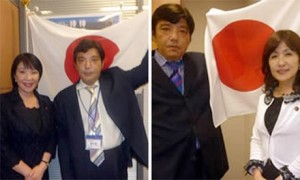本日の東京新聞夕刊に、第2次安倍内閣で総務相に就任した高市早苗衆院議員と自民党の稲田朋美政調会長ら国会議員3人が、「国家社会主義日本労働者党」を名乗る極右団体の男性と議員会館で会い、ツーショットで撮った写真が団体のホームページに公開されていたとの記事が掲載されていた。団体のページには、ナチス・ドイツの「かぎ十字」やのマークが数多く掲載され、「東亜新秩序建設」や「わが人種の優秀性を主張する」「攘夷すなわち民族浄化を推進しなければならない」といった民族差別丸出しのスローガンまで並んでいる。
高市さんも、稲田さんも団体代表の素性や思想について、知らぬ存ぜぬの洞が峠を決め込んでいるようだが、写真で明らかなように堂々たる確信犯である。暴力的な行為や公共的の場での発言に及ばない限り、「国家社会」何たら党が私的に作っているネット上で何を発言しようが自由だし構わないとも思う。しかし、議員会館で明らかに不自然な人物の面会を受けるのはどうかと思う。
両名とも自分たちは安全な場に居ながら、若者や貧困層が犠牲になる戦争を賛美するどうしようもない議員である。説得も議論も不要であろう。こういった輩には、手前らが軍服着て槍でも銃でも担いで尖兵を切ってこいと言いたい。エルサレムの中心部でハーケンクロイツと日の丸を背に、日本民族の優位性でも他民族の侮蔑でも堂々と主張してくればよい。
また、国際的恥さらしをしている人物を閣僚に入れた安倍総理の責任を追究する責任が野党にはある。さてどこが批判の急先鋒となるであろうか。期待したい。
以下、英紙「The Guardian」より転載
Neo-Nazi photos pose headache for Shinzo Abe
Two newly promoted political allies of Japanese PM shown smiling alongside far-right figure Kazunari Yamada
Pictures from Japanese neo-Nazi Kazunari Yamada’s website show him posing with Shinzo Abe’s internal affairs minister, Sanae Takaichi, and his party’s policy chief, Tomomi Inada. Photograph: GuardianBarely a week after Japan’s prime minister, Shinzo Abe, overhauled his administration amid flagging popularity, two of his senior colleagues have been forced to distance themselves from rightwing extremism after photographs emerged of them posing with the country’s leading neo-Nazi.
Sanae Takaichi, the internal affairs minister, was among a record-equalling five women selected by Abe as he attempts to make his cabinet more female voter-friendly and to increase women’s presence in the workplace.
Takaichi, an Abe ally on the right of the governing Liberal Democratic party (LDP), was pictured posing alongside Kazunari Yamada, the 52-year-old leader of the National Socialist Japanese Workers party, on the neo-Nazi party’s website.
A smiling Takaichi and Yamada appear together standing in front of a Japanese flag.
Yamada has voiced praise for Adolf Hitler and the September 2001 terrorist attacks on the World Trade Centre. In a YouTube video Yamada’s supporters are seen wearing swastika armbands, while he denies the Holocaust took place and criticises postwar Germany’s ban on the Nazi salute, accusing the country of being “no different from North Korea”.
Takaichi met Yamada “for talks” at her office in the summer of 2011, according to her office. Confirming the photographs were genuine, a spokesman for Takaichi claimed her office had been unaware of Yamada’s extremist views at the time.
“[He] was an assistant to an interviewer and was taking notes and photos,” a member of Takaichi’s staff told AFP. “We had no idea who he was back then but he requested a snap shot with her. [She] wouldn’t have refused such requests.”
Media coverage prompted her office to request that the photographs be removed but by then they had already been widely circulated on social media.
“It was careless of us,” the staff member said, adding that Takaichi did not share Yamada’s views “at all … it is a nuisance”.
A second photograph shows Yamada standing alongside Tomomi Inada, another close Abe ally who was given the powerful job of LDP policy chief. Inada’s office was quick to distance the MP from Yamada, whose website celebrates the “samurai spirit” and proclaims that the “sun shall rise again”, saying it would be disappointed if the photograph led people to “misunderstand what she does”.
While there is no evidence that either politician shares Yamada’s neo-Nazi ideology their appointment has fuelled accusations that Abe is taking his administration even further to the right.
Takaichi and Inada have both visited Yasukuni shrine, which honours Japan’s war dead, including 14 class-A war criminals; last week, Takaichi said she would visit Yasukuni again, this time in her role as minister. “I’ve been visiting Yasukuni as one Japanese individual, to offer my sincere appreciation to the spirits of war dead,” she told reporters. “I intend to continue offering my sincere appreciation as an individual Japanese.”
China and South Korea view politicians’ pilgrimages to the shrine as evidence that Japan has yet to atone for atrocities committed on the Asian mainland before and during the second world war.

